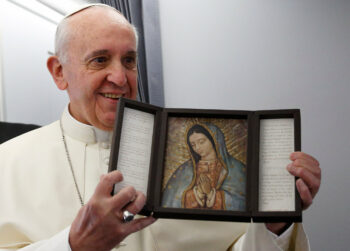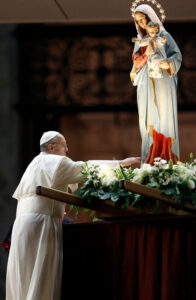Francis Speaks…

Going to the school of Mary is going to a school of faith and life. She, a teacher because she is a disciple, teaches the ‘A’ to ‘Z’ of human and Christian life. We live in the time of the Second Vatican Council. No other council in history has given Mariology as much emphasis. This tells us that the times we live in are times of Mary. But we need to rediscover Our Lady from the perspective of the Council. The wonders of Mary can be better rediscovered by going to the heart of her mystery. Two elements emerge there, highlighted by Scripture: she is a mother and a woman. The Church is also mother and woman.
Mother
Recognised by Elizabeth as "mother of the Lord" the Theotokos (mother of God) is also the mother of us all. Indeed, to the disciple John, and through him to each one of us, the Lord on the cross said: “Behold your mother!” Jesus, in that salvific moment, was giving us his life and his Spirit; and he did not let his work be completed without giving us the Virgin, because he wants us to walk in life with a mother, and even more, with the best of mothers. Saint Francis of Assisi loved her precisely because Mary is a mother. It was written of him that “he loved the Mother of the Lord Jesus with unspeakable affection, because she was the one who made the Lord of Majesty, our brother” (St Bonaventure). Our Lady as mother can make the Church and the world more fraternal.
The Church needs to rediscover her maternal heart, which beats for unity; but our Earth also needs this so it can once again be the home of all its children. Our Lady desires “to give birth to a new world, where we are all brothers and sisters, where there is a place for those discarded from our societies” (Fratelli Tutti). We need motherhood, that generates and regenerates life with tenderness, because only gifting, caring and sharing keep the human family together. Let us think of a world without mothers: it would have no future. Profits and income, by themselves, have no future; on the contrary, sometimes they increase inequalities and injustices. Mothers, on the other hand, make each child feel at home and give hope.
Woman
 Our Lady – this is the other essential element – is a woman. Perhaps the oldest Mariological data in the New Testament says that the Saviour “was born of a woman”. In the Gospel, moreover, Mary is the woman, the new Eve, who intervenes for our salvation from Cana to Calvary. Finally, she is the woman clothed with the sun who cares for the offspring of Jesus. Just as the mother makes the Church a family, the woman makes us a people. It is not by chance that popular piety naturally inclines towards Our Lady. It is important that Mariology follows it closely, promotes it, sometimes purifies it, always paying attention to the “signs of the Marian times” that are threads of our time.
Our Lady – this is the other essential element – is a woman. Perhaps the oldest Mariological data in the New Testament says that the Saviour “was born of a woman”. In the Gospel, moreover, Mary is the woman, the new Eve, who intervenes for our salvation from Cana to Calvary. Finally, she is the woman clothed with the sun who cares for the offspring of Jesus. Just as the mother makes the Church a family, the woman makes us a people. It is not by chance that popular piety naturally inclines towards Our Lady. It is important that Mariology follows it closely, promotes it, sometimes purifies it, always paying attention to the “signs of the Marian times” that are threads of our time.
Among these, there is precisely the role of women: essential for the history of salvation, it cannot but be essential for the Church and the world. But how many women do not receive the dignity that is due to them! The woman, who brought God into the world, must be able to bring her gifts into history. Her gift and style are needed. Theology needs this, so that it is not abstract and conceptual, but delicate, narrative, vital. Mariology, in particular, contributes to bringing to culture, as through art and poetry, the beauty that humanises and instils hope. And the call is to seek additional dignified spaces for women in the Church, starting from the common baptismal dignity. Because the Church, as I said, is a woman: like Mary. She is a mother: like Mary.
Extracted from Pope Francis’ Address to the Pontifical Theological Faculty “Marianum” October 24, 2020. Translated from the Spanish.
 Entries(RSS)
Entries(RSS)